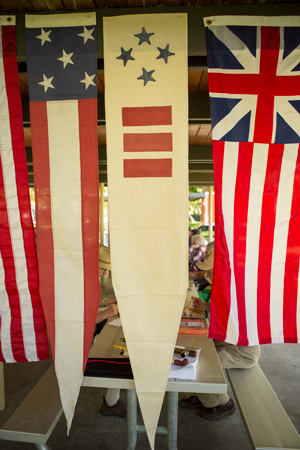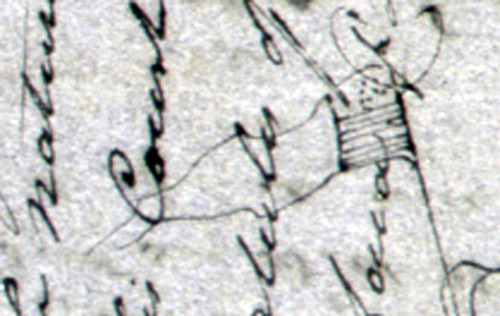Fifteen Stars and Stripes
15-Star Flag
© 2011 by Kristopher K. Townsend. Permission to use granted under the Creative Commons Attribution-Share Alike 4.0 International license.
The expedition’s supplies included an unknown number of American flags resembling the one seen here. Those that the journals refer to only as being “of second size,” and “of third size” (at least nineteen of the latter), were given to selected Indian leaders as tokens of peace, and to represent a bond of union between the tribe and the United States of America.
Beginning in the seventeen-seventies, a half-dozen or more flags of different designs and colors were used in the various colonies. The flag of thirteen stars and thirteen stripes, signifying the thirteen original colonies, was authorized by Congress in 1777. The colors, the same as those of the British flag, were chosen at a time when many Colonial leaders still hoped for reconciliation with Great Britain.
Eighteen years later, after Vermont and Kentucky were admitted to the Union, Congress established the format you see here: seven white and eight red stripes, with 15 five-pointed white stars in a blue field.
Congress made no provision for further changes in the flag when new states joined the Union. So the old 15-star flag was still the official one at the time the Lewis and Clark expedition began, although there were actually 17 United States. They were, in order of admittance: Delaware (1787), Pennsylvania (1787), New Jersey (1787), Georgia (1787), Connecticut (1788), Massachusetts (1788), Maryland (1788), South Carolina (1788), New Hampshire (1788), Virginia (1788), New York (1788), North Carolina (1789), Rhode Island (1790), Vermont (1791), Kentucky (1792), Tennessee (1796), and Ohio (1803). The next state to be admitted was Louisiana, in 1812.
The present design was established in the Flag Act of 1818: six white stripes, seven red, and a blue field with one star for each state in the Union.
Now about those other names: The men of the expedition wouldn’t have referred to their flag as the “star-spangled banner” because that expression was coined by Francis Scott Key in 1814. Key’s poem, set to a tune that had been popular for many decades, officially became our national anthem in 1931.
They wouldn’t have called it “Old Glory,” either, because that name was given it by a young sea-captain of Salem, Massachusetts, in 1824.
The expedition carried just one large flag, which probably flew above their major camps. We don’t know just how big it was, but before they left Fort Clatsop on 18 March 1806, they cut it up to make five “robes,” or capes, to trade with Indians for food and horses. That was perfectly legal then. The first law prohibiting desecration or improper use of the flag was passed by Congress in 1917.
Incidentally, the story that Betsy Ross sewed the first Stars and Stripes in 1776 appeared nearly a century later, and doesn’t jibe with historical facts.
Signal and Signature Flags
Painting created by Split Rock Studios, Sioux City, Iowa. Original in the collection of the Lewis and Clark Trail Heritage Foundation and photographed by Kristopher Townsend.
Above: a signal flag hoisted above Blackbird‘s grave can be seen in the upper left corner.
In addition to the various American flags, the Corps used two other kinds. Clark’s entry for 11 August 1804, tells us that morning he and Lewis, with ten of their men, climbed to the summit of the bluff overlooking the Missouri where Blackbird, an Omaha chief, had been buried 4 years before. On his grave, a mound of earth about twelve feet in diameter and six feet high, they erected an eight-foot pole on which they hoisted a white flage bound with red Blue & white.” Its pure white expanse respectfully acknowledged that Blackbird had been a peace-loving chief, while its tricolored edging discreetly stated that his grave, and the homeland of his people, were now on American soil.
On the thirteenth, according to Private Whitehouse’s journal, they “Sent a Serjt. & 4 Men with a white flagg, to the [Omaha] Village to invite them to Come to a treaty, but the[y] found no Indians at the Village.”
They also carried one or more red flags. Late in September, as the climax of their crucial encounter with the Lakota Sioux (Teton)[1]The ethnonym Teton (tee-tahn) was a transliteration of a Dakotan (Siouan) word meaning “plains.” It bears no connection with its homonym, the common western placename Teton—French for … Continue reading Sioux approached, the captains dispatched a messenger to the Sioux with an explanation of “the Cause of our hoisting the red flag undr. the white, if they were for peace Stay at home & do as we had Derected them, if the[y] were for war [or] were Deturmined to Stop us we were ready to defend our Selves.” Three days later, on 30 September 1804, “the Indians assembled on S. Shore hoisted a white flag. we then took down our red flag. directly after they hoisted another. We then took them to be our friends.” Apparently the captains’ diplomacy had succeeded. For the present, at least, the crisis was over.
Naval Ensigns and Pennants
Two Pennants and Grand Union Flag
Flags provided by Chet Chatsky. Photo © 2014 by Kristopher K. Townsend. Permission to use granted under the Creative Commons Attribution-Share Alike 4.0 International license.
Clark included a naval pennant, or ensign, in his sketch of the barge (called the ‘boat’ or ‘barge’ but never the ‘keelboat’). The figure outlined by the stars in the canton is uncertain.
In 1801 Ann Hoskin, a seamstress in Philadelphia, made an ensign for the United States Military Department with a hoist of 9 inches and a fly of 6 feet.[2]The receipt is in the Consolidated Correspondence File 1794-1915, Office of the Quartermaster General, Record Group 92, Box 304, National Archives. Cited in Grace Rogers Cooper, Thirteen-Star Flags: … Continue reading
The expedition was mostly water-born; its commanders consistently referred to their journey as a voyage. Upon their departure from Fort Mandan on 7 April 1805, Lewis proudly referred to their six dugout canoes and two pirogues as “this little fleet.” Historically, a senior officer in command of a detached corps or squadron was entitled to fly a pennant from his command ship[3]W. H. Smyth, The Sailor’s Word-Book: An Alphabetical Digest of Nautical Terms (Glasgow: Blackie and Son, 1867), s.v. “pennant.”—either a long, slender three-cornered flag (called a burgee) such as the one the expedition flew, or else a broad swallow-tailed white flag. In either case the iconic fields were arranged to fit in the “hoist” or flagstaff end.
There was at least one more flag of exceptional importance to the expedition—their naval ensign (Figure 8).[4]Hugh F. Rankin, “The Naval Flag of the American Revolution,” William and Mary Quarterly, Third Series, Vol. 11, No. 3 (July 1954), 340-353. Historically, the ensign had been the official … Continue reading In the U.S. Army, beginning with the Military Peace Establishment Act of 1802, the term ensign denoted a junior infantry officer next below a second lieutenant. By then the Gadsden flag had long been out of date and therefore inappropriate.
Consistent with naval law and practice, from the beginning of the expedition the captains ordered the men in charge of both pirogues to fly the American flag. As they ascended the Missouri above the Great Falls, harboring premature expectations of meeting Sacagawea‘s people any day, and even seeing evidence that unidentified Indians were nearby, perhaps watching them, on 23 July 1805 Lewis “ordered the canoes to hoist their small flags in order that should the indians see us they might discover that we were not Indians, nor their enemies.” Furthermore, American naval tradition dictated (up until 1912) that flags on small boats were to be of the 13-star, 13-stripe design established by the Flag Act of 1777 . On 6 August 1804, Clark noted that the red pirogue had “lost her Colours” in a severe thunderstorm. How many ensigns they had with them is not known, but if they had no replacement, the captains might have considered the loss potentially serious, for the absence of “colours” might have signified that the boat was out of commission, which would have made it fair game for fresh-water thieves or pirates who could assume that its crewmen were prepared to surrender.[5]Smyth, s.v. “Ack-men.” The captains might not have expected Indian observers to think of this, but experienced British or Spanish boatmen might have taken the sign seriously.
The Corps met many other boats on the lower Missouri, both going and coming. On 14 September 1806, nine days from the end of their journey, the captains’ scraggly little fleet of five dugouts led by the white pirogue were pulling hard to stay ahead of the current, their firelocks primed and all hands on the lookout for the piratical Kansa Indians. In mid-afternoon they met three large boats—”Keel Boats,” Sgt. Ordway called them—out of St. Louis, bound for the Yanktons and the Omahas to trade for furs. “We . . . Spread our flags,” Ordway reported, whereupon “they Sailed up to us and halted with us a Short time.”
Sources
Bob Saindon, “The Flags of the Lewis and Clark Expedition,” We Proceeded On, Vol. 7, No. 4. Available at https://lewisandclark.org/wpo/pdf/vol7no4.pdf#page=22.
Whitney Smith, The Flag Book of the United States. New York: William Morrow & Company, Inc., pp. 66-74. Encarta, 1994.
Milo M.Quaife, Melvin J. Weig, and Roy E. Appleman, The History of the United States Flag. (New York: Harper, 1961.
Notes
| ↑1 | The ethnonym Teton (tee-tahn) was a transliteration of a Dakotan (Siouan) word meaning “plains.” It bears no connection with its homonym, the common western placename Teton—French for “breast”—as in “Grand Teton,” the highest peak (13,770 feet) in the Teton Range of mountains in the northwest corner of Wyoming. Nor does it denote the Teton Buttes (4452 ft), nor Teton Peak (8399 ft) at the headwaters of the river itself now known as the Teton River, which Clark named the anzey. William Bright, “A Glossary of Native American Toponyms and Ethnonyms from the Lewis and Clark Journals,” Names, Vol. 52, No. 3 (September 2004), 163-237, s.v. “Teton.” |
|---|---|
| ↑2 | The receipt is in the Consolidated Correspondence File 1794-1915, Office of the Quartermaster General, Record Group 92, Box 304, National Archives. Cited in Grace Rogers Cooper, Thirteen-Star Flags: Keys to Identification (Washington, D.C.: Smithsonian Institution Press, 1973), 15. |
| ↑3 | W. H. Smyth, The Sailor’s Word-Book: An Alphabetical Digest of Nautical Terms (Glasgow: Blackie and Son, 1867), s.v. “pennant.” |
| ↑4 | Hugh F. Rankin, “The Naval Flag of the American Revolution,” William and Mary Quarterly, Third Series, Vol. 11, No. 3 (July 1954), 340-353. Historically, the ensign had been the official bearer of the regimental flag. Upon being assigned to command the expedition to take the Mandan Chief Sheheke and his family home from the U.S., Nathaniel Pryor received a commission as an ensign in the infantry. |
| ↑5 | Smyth, s.v. “Ack-men.” |
Experience the Lewis and Clark Trail
The Lewis and Clark Trail Experience—our sister site at lewisandclark.travel—connects the world to people and places on the Lewis and Clark Trail.
Discover More
- The Lewis and Clark Expedition: Day by Day by Gary E. Moulton (University of Nebraska Press, 2018). The story in prose, 14 May 1804–23 September 1806.
- The Lewis and Clark Journals: An American Epic of Discovery (abridged) by Gary E. Moulton (University of Nebraska Press, 2003). Selected journal excerpts, 14 May 1804–23 September 1806.
- The Lewis and Clark Journals. by Gary E. Moulton (University of Nebraska Press, 1983–2001). The complete story in 13 volumes.





